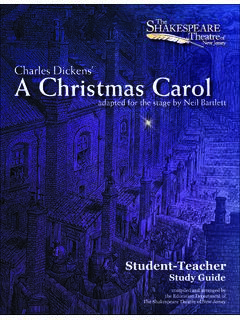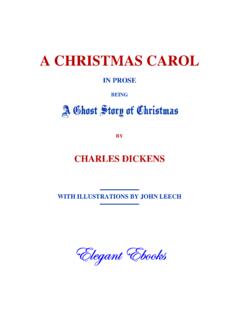Transcription of Why did Charles Dickens write A Christmas Carol?
1 Geva Theatre Center, Rochester NY A Christmas Carol 2013 Why did Charles Dickens write A Christmas Carol? Charles Dickens was a major celebrity easily identified in England and in Europe, virtually mobbed on his visits to the United States for reading tours. He was also a social reformer, deeply concerned with the harsh plight of the lower and working classes a situation he sought to remedy through the use of his writing and the recognition that it brought him. He frequently took part in benefit engagements and charity events; his marathon walks throughout London, particularly its less prosperous neighborhoods, could be considered precursors of today s fact-finding missions. Dickens was not alone in his desire to better mid-nineteenth century England.
2 He was, however, able to reach a larger audience than most using his fame as a platform from which to publicize the deplorable conditions in which the poor and destitute lived and worked. He would continue this conversation with his audience until his death in 1870. What did Dickens want to change? Dickens was particularly concerned with the health, treatment and well-being of children, always among the most vulnerable members of any society. By the mid-nineteenth century, it is believed that well over 100,000 children in London had never attended a school of any kind. And of those who did receive some sort of education, many attended either schools run by private owners for the purpose of making a profit or, more often, ragged schools.
3 Ragged schools were charity institutions created to provide at least a rudimentary education for destitute children. In many instances, the ragged schools also provided food, clothing and lodging for their students. These schools received no government support and existed solely on charitable donations. As a result, the schools were usually found to be in slum-like conditions in disreputable sections of town. The buildings were often in disrepair poorly ventilated, severely overcrowded, overrun with various strains of disease and covered in the soot and filth resulting from the growing industrialization of the country hardly an environment conducive to proper teaching and learning. Those children who did not attend school ragged or otherwise worked.
4 They worked in factories, mines, shipyards, construction businesses and chimney sweep enterprises. Some children had been working since the age of three and in some of the more dangerous workplaces, such as iron or coal mines, the life expectancy generally didn t exceed the mid-twenties. Such were the depths of poverty in nineteenth century England that it was generally assumed that a lower or working class family could not survive without the wages, however small, earned by each family member, including children a fact not lost on any number of unscrupulous mine and factory owners. As a result of increased mechanization in such workplaces, children were often the preferred workforce they could Geva Theatre Center, Rochester NY A Christmas Carol 2013 be paid less than adults, often no strength was required to operate a machine and, as these machines were completely new, there was no need for experienced adult laborers.
5 It was not uncommon in the earlier part of nineteenth century England for children to work sixteen hour days (the same as adults) it wasn t until a parliamentary act in 1847 that the work day, for children as well as adults, was limited to ten hours. Families that could not secure adequate housing or employment usually ended up living in workhouses massive, privately-owned industrial structures designed to shelter and support the destitute of London. Families in workhouses were usually separated by gender and age with only limited contact between them. The workhouse was designed to be virtually unendurable, a humiliating and degrading experience meant to act as a deterrent to the sin of poverty. While some people used the workhouses as a way to avoid work and responsibility, the vast majority entered them only reluctantly and as a very last resort.
6 Not unlike the ragged schools, workhouses were often dilapidated and unsanitary affairs, perfect environments for vice, crime and disease. Why did he care about these changes? Dickens never quite experienced the same levels of poverty as so many of his fellow Londoners, but his family did contend with hardship and separation. After losing his job as a pay clerk for the British Navy in 1824, Dickens father was sent to a debtor s prison; he was followed soon after by his wife and children with the exceptions of their daughter Fanny (who remained in school) and Charles who had been removed from school and sent to work in a boot-blackening factory. Although his stay in the factory was comparatively short, the experience for Charles was life-altering and would become a major influence on his work (as a writer and as an advocate) for the remainder of his life.
7 He resumed his schooling after his father s prison sentence had ended but never forgot the sense .. of being utterly neglected and hopeless while working in the factory a sense, no doubt, shared by the multitudes of poverty-stricken Londoners. In A Christmas Carol, the squeezing, wrenching, grasping Ebenezer Scrooge, when asked for a charitable donation for the less-fortunate, responds by asking after the state of prisons and workhouses and the status of several poor-relief laws sponsored by taxes. This, Scrooge believes, is the extent of his duty to the poor and his sentiments were common ones, particularly among the upper classes. The Poor Law Amendment Act of 1834, for example, Geva Theatre Center, Rochester NY A Christmas Carol 2013 was intended to end relief to any able-bodied person and make the remaining charity as minimal as possible to deter all but the most desperate from requesting such aid.
8 It was Dickens belief in a social contract, an unbreakable bond amongst all people, which put him at odds with this line of thinking and informed much of his writing writing that he would use time and again to call attention to the plight of the poor, often raising the thorny question of who was ultimately responsible for the care of the less fortunate the government? The Church? Individuals? Some combination of the three? Dickens was an ever-present voice in this perpetual conversation. Dickens work, however, also addressed the importance of home and family, of kindness and gentleness and humility as well as the potentially insulating and isolating effects of money, class and status. Dickens wrote about these topics in letters, articles, pamphlets, essays and, of course, his novels which were serialized as a way to make them more affordable for readers of all classes.
9 It was a visit to the Field Lane ragged school in the Saffron Hill district of London that led Dickens to write A Christmas Carol in 1843. Dickens initially visited the school as a representative of his wealthy friend Angela Burdett-Coutts in order to help her decide if the school was in need of her financial assistance. He was so dismayed by the sickening atmosphere .. of taint and dirt and pestilence that he immediately planned an article about the school for the Edinburgh Review. Within a month of the visit to Field Lane, Dickens had begun work on A Christmas Carol. He would finish it within six weeks. How are Dickens s beliefs reflected in A Christmas Carol? It was in the writing of A Christmas Carol that Dickens pulled together the strands of much of his previous work the concerns for the welfare of the poor and needy (and particularly their children), the plight of the working class, the alleged indifference of the upper class to those less fortunate, the importance of family and home.
10 The book, however, also addressed the more open-ended question of what might happen should circumstances not change. Dickens , in letters to friends, expressed a fear that unless the needs of poor and desperate children were met, nineteenth-century civilization would be forever altered and not for the better. It is telling that Dickens names two of his characters Want and Ignorance, warning to beware of both but especially Ignorance for Ignorance is Doom, unless it be erased. Equally instructive is the fact that these characters are children essentially powerless to change their situation, dependent upon society for their care and well-being. Through Ebenezer Scrooge and his ghostly visitations, Dickens advances his concerns of what may happen to society in the absence of immediate changes the poor getting poorer, the sick getting sicker, the lower classes trapped in a spiral of poverty, a widening gulf between those with much and those with little.





